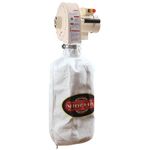
Q:
I use a combination blade in my tablesaw for rips and crosscuts in boards as well as plywood and MDF. The results are good enough, but would I get better results if I used an assortment of blades?
Chester Hagen, Wheat Ridge, CO
A:
In my experience, a sharp combination blade with a low tooth count makes the best overall choice. A combination blade has two types of teeth: Rip-cutting teeth are square to the blade and chisel small chips out of the wood; crosscutting teeth have alternate pointed edges and slice across the grain like knives.
A combination blade isn’t perfect for either ripping or crosscutting, but we don’t tend to notice as long as the blade is sharp. A low-tooth-count combination blade lets you use a fast feed rate for thick hardwoods; the blade removes chips quickly while reducing friction and heat buildup. As the tooth count increases, the maximum feed rate drops. That may yield a smoother cut surface because each tooth takes a smaller bite, but it also increases friction and heat. Cutting cherry with a high-tooth-count blade may produce enough heat to discolor the wood.
With a low tooth count, you can slow the feed rate when cutting thin hardwood, most softwoods, and material such as MDF. That increases the effective cuts per inch for a smoother surface.
Fine Woodworking Recommended Products

Ridgid R4331 Planer

Shop Fox W1826

Ridgid EB4424 Oscillating Spindle/Belt Sander






















Log in or create an account to post a comment.
Sign up Log in